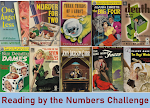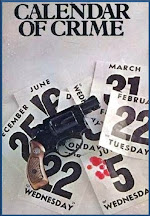 I originally read Frances and Richard Lockridge's Death of a Tall Man back in 2010 (back in my early days of blogging). For my first review, please go HERE. I picked it up again this year as the opening Clue in my second "Famous Person" entry in my new Super Book Password Challenge. The clue portion of the title is in bold.
I originally read Frances and Richard Lockridge's Death of a Tall Man back in 2010 (back in my early days of blogging). For my first review, please go HERE. I picked it up again this year as the opening Clue in my second "Famous Person" entry in my new Super Book Password Challenge. The clue portion of the title is in bold.Visiting with Pam and Jerry North, Acting Captain Bill Weigand, and Sergeant Mullins was just as much fun this time as it was in 2010. It's just like visiting old friends. It didn't matter that I already knew who did it--that just allowed me to pay more attention to the relationships between our recurring characters and to really absorb Pam's interesting logic and manner of speaking.
Of course, we all know that it isn't reasonable for her and Jerry to be as involved in as many murders as they are. But the stories would lose a lot of their charm without them. It is especially delightful to listen to Mullins worry about how O'Malley (in command of the detective bureau) will explode if he finds out "those Norths" are mixed up in it again. Mullins should know--there's no way to keep them out and O'Malley will survive.
I gave the book ★★★★ when last I read it. The rating still stands.
Quotes
It occurred to Grace Spencer, sometimes, that Andrew Gordon was excessively interested in what people could see out of their eyes, and insufficiently concerned with what other people could see by looking into them. Not that, as things stood, it would make any difference to her; it was fortunate, indeed, that he never saw anything in her eyes except their physical efficiency. (p. 13)
Things were so easily a mess at twenty. You had so little time at twenty; even when you were only thirty-two you had more time. It was a most ingenious paradox. (p. 22)
The human mind was seldom as logical as it tried to make itself. (p. 45)
...she was as unlikely to get in touch with anybody if her Dan came back, as she was to shave off her softly waving brown hair, Bill told himself. Less likely. So that that would have to be taken care of. Humanity was frequently exasperating; particularly humanity in love. (p. 60)
Weigand was patient. He did not follow any of the alleys Smith opened for him. He agreed in general; he agreed in detail; he praised Smith's attitude, and mentioned how much better it would be if all people were as reasonable and straightforward. (p. 66)
PN: I still think it was something she saw when he was leaving.
JN: I know. Because people who are about to be murdered look different from people who aren't. It shows on their faces....
PN: No. Really. Because murders are the end of something else, almost always....And the victim is worried too, just as much as the murderer. (Pam North, Jerry North; p. 117)
Everybody's worried in the morning. It's the natural state of man. Particularly at what would be about seven thirty. (Jerry; p. 117)
Humanly it was unbelievable. But her mind stopped her there. About people little was really unbelievable.... (p. 128)
JN: Listen. Where are you? Where've you been?
PN: Lots of places. The last one blew up. (Jerry, Pam; p. 131)
[about Pam] That, the doctor told Jerry, was the aftermath of shock. She would, if she were his wife, spend a day or two in bed. ("Not if I were his wife," Pam said cryptically, when they were outside. Jerry examined that remark and, in the interest of finding out what had happened, decided not to pick it up.) (p. 133)
"Those damn pilot lights," the detective had said. "Half the time somebody decides to bump himself off with the gas he forgets the pilot light. And the hold place blows up. They never learn."
It was not entirely clear who never learned. As nearly as Pam could work it out, the detective seemed to mean that the people who committed suicide never learned. It seemed, Pam told Jerry, an odd thing to reproach them with. (pp. 134-5)
"Look," Pam said, "no woman's going to buy a new hat just before she and her lover kill her husband."
Jerry shook his head at that. He didn't, he said see why not. Women would, as far as he could see, buy hats any time. (p. 138)
It's always useful to know the impossibles. Along with the possibles. Narrows the field. (Bill Weigand; p. 141)
BW: Right. So for God's sake--don't you get intuitional on me.
SM: O.K., Loot, I won't get institutional. (Bill Weigand; Sergeant Mullins; p. 144)
And when people were married, Andy had told her--still gently--there would be a new kind of intensity between them; a new kind of sensitiveness. If people were married at all. It was hard to explain, but words meant more then; gestures meant more. You saw things that you would, before, have overlooked. (p. 147)
But neither of them looked as if they minded being wet and cold. They looked as if they were very warm and contented. From the expression on their faces, they might have been sitting in front of a fire. Actually, Pam North thought, they are. In the only sense that makes much difference. (p. 186)
















































